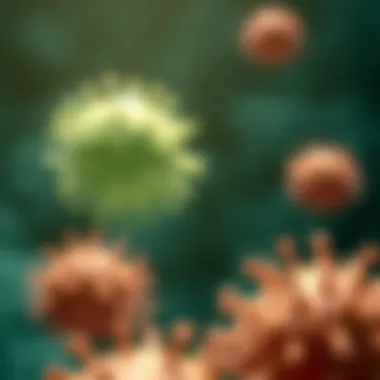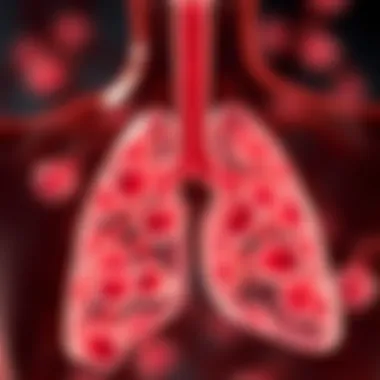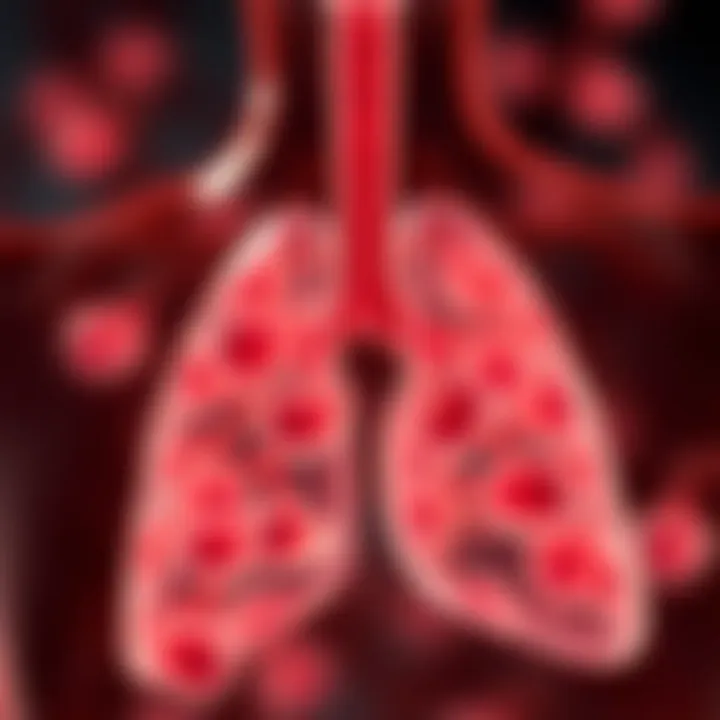Interleukin 4's Impact on Asthma Pathophysiology


Intro
Asthma has become a prevalent health concern worldwide, affecting millions of individuals regardless of age or background. Among the culprits behind this inflammatory respiratory disease, interleukin 4 (IL-4) stands out due to its significant influence on immune system regulation and inflammation. This fraternal cytokine plays a crucial role in managing how the body responds to allergens and other triggers that can exacerbate asthma symptoms. Understanding the intricacies of IL-4 is essential for both clinical practitioners and researchers focusing on innovative treatment strategies.
As we delve deeper into the role of IL-4 in asthma pathophysiology, we will uncover how this single molecule can orchestrate a wide array of biological responses, setting the stage for allergic reactions and inflammation that characterize asthma. It’s a complex web where the slightest dysregulation may serve as a catalyst for exacerbations that can severely impact a patient's quality of life. Therefore, a comprehensive look at IL-4's biological functions and its regulatory role within the lungs is pivotal to improving asthma management.
In this article, we'll explore not only the current understanding of IL-4 and its mechanisms but also the innovative research trends that aim to harness this knowledge in therapeutic settings. So, buckle up as we navigate through a landscape where science and medicine intersect to shed light on asthma's turbulent pathogenesis.
Prologue to Interleukin
Interleukin 4, or IL-4, stands as a pivotal player in the realm of immune responses, particularly in the context of asthma. As the article unfolds, the significance of IL-4 in asthma pathophysiology will become evident, highlighting its central role in mediating allergic reactions and inflammation. Understanding IL-4 is not merely an academic exercise; it can unravel potential pathways for novel therapeutic strategies aimed at alleviating asthma symptoms. By examining its functions, interactions, and the consequences of its dysregulation, we can better appreciate the intricate web that connects this cytokine to asthma exacerbations.
Definition and Characteristics
Interleukin 4 is a cytokine primarily produced by T cells, mast cells, and basophils. It falls under the broader category of interleukins, each of which carries messages crucial for orchestrating immune responses. IL-4 is produced in response to allergen exposure and various stimuli.
Some key characteristics include:
- Molecular Structure: IL-4 has a relatively simple structure, consisting of 129 amino acids. It features a four-helix bundle configuration critical to its interactions with receptors.
- Receptor Interaction: IL-4 operates through specific receptors on cells, mainly the IL-4 receptor alpha and the common gamma chain. This interaction triggers signaling cascades that influence cell behavior.
- Biological Functions: The primary role of IL-4 includes promoting B-cell differentiation and stimulating immunoglobulin E (IgE) production. IgE is notorious for its association with allergic responses, thus linking IL-4 directly to asthma's allergic component.
These characteristics are essential for understanding how IL-4 contributes to the complex pathophysiology of asthma.
Historical Context
The journey of understanding interleukin 4 is woven into the fabric of immunology. Discovered in the late 1980s, IL-4 was first recognized for its capacity to induce B-cell proliferation and differentiation. As research continued, its importance became broader, particularly in the context of allergic diseases.
Key milestones in the historical arc of IL-4 include:
- The identification of its gene and subsequent cloning in 1986.
- Discoveries linking IL-4 to asthma made headlines in the 1990s, paving the way for attention to its role in allergic inflammation.
- More recent studies have highlighted IL-4’s involvement not just in asthma, but in other conditions such as eczema and allergic rhinitis, thereby confirming its importance across various settings.
This historical backdrop sets the stage for appreciating IL-4's significance in contemporary research and therapeutic developments, making it a focal point in discussions about asthma management and treatment.
The Immune System and Cytokine Function
Understanding the immune system is critical in comprehending how interleukin 4 (IL-4) functions within asthma pathophysiology. The immune system, our body's defense mechanism, acts as a protective barrier against pathogens, allergens, and various irritants. It involves a complex network of cells, tissues, and signaling molecules working in harmony. Cytokines, like IL-4, play a key role as signaling molecules that mediate and regulate immune responses, therefore their function is vital in both health and disease, particularly in allergic conditions like asthma.
Overview of the Immune Response
The immune response can be generally categorized into two main types: innate and adaptive immunity. Innate immunity is the first line of defense, acting quickly and non-specifically to any foreign invader. It involves barriers like skin, mucous membranes, and various immune cells ready to tackle immediate threats. On the other hand, adaptive immunity provides a tailored response to specific pathogens. It develops over time and includes the formation of memory cells that allow the body to remember and rapidly respond to previously encountered invaders.
Asthma, fundamentally an allergic condition, complicates this response. In the context of asthma, the immune system overreacts to normally harmless substances, leading to inflammation and airway hyperresponsiveness. Here is a brief overview of immune cells and what they do:
- Macrophages: These cells engulf and digest pathogens and also alert other immune cells about the presence of a danger.
- T-cells: Particularly, T cells secrete cytokines like IL-4 which orchestrate the allergic response by influencing B cells to produce IgE.
- B cells: They produce antibodies, and IgE specific to allergens plays a critical part in asthma.
- Mast cells: When activated, they release histamines and other inflammatory mediators that lead to asthma symptoms.
Thus, understanding the immune response, and especially the role of various cytokines, is paramount for diagnosing and treating asthma.
Cytokines: Signaling Molecules
Cytokines are incredibly important in the regulation and communication of the immune system. Think of them as messengers. They facilitate the communication between cells, coordinating the body's response to infection or injury. Each cytokine serves specific functions, influencing the behavior of immune cells and shaping the nature of the immune response.
Interleukin 4 has a distinct role in driving allergic inflammation. It is primarily produced by T cells and not only encourages B cells to switch to producing Immunoglobulin E but also enhances the survival and proliferation of mast cells, both of which are significant players in asthma exacerbations. Here's how cytokines can behave in the immune landscape:
- Pro-inflammatory Cytokines: Like IL-1 and IL-6, they promote inflammation. In asthma, an overproduction could lead to chronic inflammation.
- Anti-inflammatory Cytokines: These molecules, such as IL-10, help reduce inflammation, balancing the immune response.
- Growth Factors: Certain cytokines act as growth factors, promoting cell proliferation and repair, which is often necessary in chronic conditions.
To sum it up, the intricate dance of these cytokines, including IL-4, orchestrates the immune response towards allergens and is crucial for understanding asthma pathology.
"Cytokines are not just sequencers in the orchestra of immunity; they're the conductors that decide the piece being played."
"Cytokines are not just sequencers in the orchestra of immunity; they're the conductors that decide the piece being played."
Ultimately, grasping how these components of the immune system interplay forms the foundation for advancing asthma research and treatments, aiming for effective therapeutic strategies targeted at IL-4 and its pathways.


Pathophysiology of Asthma
Understanding the pathophysiology of asthma is crucial for grasping how interleukin 4 fits into the broader picture of this respiratory condition. Asthma is not merely a simple disease; it's a multifaceted disorder characterized by persistent airway inflammation, heightened bronchial hyperreactivity, and obstruction leading to difficulty in breathing. Recognizing the specific mechanics at play helps in identifying effective treatment strategies and underlines the importance of cytokines like interleukin 4 in modulating immune responses.
What Is Asthma?
Asthma is a chronic lung disease marked by episodes of wheezing, shortness of breath, chest tightness, and coughing. It often affects individuals from a young age, but can emerge at any point in life. This condition is linked with both genetic and environmental factors, where allergens, pollutants, and respiratory infections can trigger acute flare-ups.
Mechanistically, asthma can be viewed through the lens of airway inflammation, where various cell types—such as eosinophils, T-helper cells, and mast cells—play vital roles. These cells mediate pathways that cause airway inflammation, ultimately leading to reversible airflow obstruction, which is a hallmark sign of asthma.
Mechanisms Underlying Asthma
Asthma develops through a series of interconnected mechanisms involving complex immunological responses. The following elements are particularly important:
- Allergic Sensitization: Exposure to allergens can lead to the body developing an abnormal response. For example, when a person comes into contact with pollen or dust mites, their immune system can start producing specific immunoglobulin E (IgE). This antibody plays a crucial role as it directly influences the severity and frequency of asthma attacks.
- Airway Inflammation: Upon allergen recognition, a cascade of inflammatory responses occurs. Interleukin 4 is particularly significant in this stage, as it promotes the differentiation of naïve T-cells into T-helper 2 (T) cells, enhancing the production of IgE.
- Bronchoconstriction: During an asthma attack, signals lead to contraction of smooth muscles in the airway walls, which narrows the air passages. This spasm results in immediate symptoms such as coughing and wheezing.
- Airway Remodeling: With chronic asthma, structural changes can occur in the airway walls due to persistent inflammation. This remodeling can make airways thicker and less elastic, leading to a more chronic obstruction of airflow.
In summary, asthma is a condition that strikes at the intersection of genetic susceptibility and environmental triggers. Interleukin 4 stands out among the myriad cytokines involved, primarily due to its role in orchestrating the allergic response and maintaining chronic inflammation. The constant interaction of multiple immune factors results in the heightened asthma severity, making the pathophysiology both complex and worthy of careful study.
"A deep dive into the multifaceted nature of asthma reveals that understanding cytokines like IL-4 can be pivotal to innovative treatment modalities."
"A deep dive into the multifaceted nature of asthma reveals that understanding cytokines like IL-4 can be pivotal to innovative treatment modalities."
This comprehensive overview sheds light on how an understanding of asthma’s pathophysiology can lead to targeted and effective therapies and emphasizes the need to delve deeper into interleukin 4’s role in this process.
IL-4 and Allergic Responses
Interleukin 4, commonly referred to as IL-4, plays a pivotal role in the body's allergic response mechanism, particularly in the context of asthma. As a cytokine that is primarily produced by T helper type 2 (T) cells, IL-4 facilitates the transition of immune responses from a general to a specialized allergic pathway. Understanding this dynamic is crucial, as it sheds light on how allergies develop and how they exacerbate asthma symptoms, providing insight that is valuable for both academic research and clinical applications.
Role in IgE Production
One of the cornerstone functions of IL-4 is its influence on immunoglobulin E (IgE) production. In a typical immune response, the body identifies allergens—substances that can provoke an allergic reaction—and mobilizes its defenses. Here, IL-4's role becomes significant as it promotes the differentiation of B cells into IgE-producing plasma cells. This process amplifies the immune response significantly.
- Mechanism of Action: When IL-4 binds to its receptor on B cells, it activates various intracellular signaling pathways. This leads to the expression of specific genes responsible for IgE synthesis.
- Consequences of IgE Elevation: Elevated IgE levels correlate with increased sensitization to allergens, making the body more reactive to environmental triggers such as pollen, dust mites, and pet dander. Over time, high IgE levels contribute to chronic inflammation and airway hyperresponsiveness, key features of asthma.
The relationship between IL-4 and IgE production underlines the importance of targeting IL-4 pathways to mitigate allergy-induced asthma. By inhibiting IgE synthesis, we could potentially reduce the frequency and severity of asthma attacks in sensitized individuals.
Mast Cell Activation
Mast cells are another crucial component in the allergic response, and IL-4 plays a substantial role in their activation. These cells, located in tissues throughout the body, are loaded with granules that contain histamines and other chemicals, ready to be released upon encountering an allergen.
- Activation Process: When IL-4 is present, it not only enhances the production of IgE but also primes mast cells to respond vigorously to future encounters with allergens. Mast cells express high-affinity IgE receptors (Fc\u03b5RI), and when allergen-IgE complexes form, these cells degranulate, releasing potent mediators that cause the symptoms associated with asthma.
- Effects on Airway Function: The release of histamine and other inflammatory substances causes bronchoconstriction, mucus secretion, and airway remodeling. This chain reaction escalates inflammation, causing the airway to swell and narrow, which is particularly problematic for those with asthma.
Understanding the interplay between IL-4 and mast cell activation provides critical insights into new therapeutic approaches for asthma management. By modulating this axis—either through monoclonal antibodies targeting IL-4 or small molecule inhibitors—it might be possible to control allergic responses more effectively and improve patient outcomes dramatically.
"The role of IL-4 in allergic responses sets the stage for significant interventions that can alter the trajectory of asthma management."
"The role of IL-4 in allergic responses sets the stage for significant interventions that can alter the trajectory of asthma management."
In summary, IL-4 is at the center of allergic responses through its regulation of IgE production and mast cell activity. Recognizing this importance is fundamental for developing innovative treatment strategies aimed at reducing the burden of asthma linked to allergic components.
Mechanism of Action of IL-4 in Asthma
Interleukin 4 plays a pivotal role in the pathophysiology of asthma, acting as a central hub around which various immunological events revolve. Grasping how IL-4 influences asthma is crucial for developing new therapeutic strategies, given its profound impact on inflammation and immune response modulation. IL-4 doesn't just play a singular role; rather, it orchestrates a complex network of interactions that contribute to asthma's manifestation and progression. Understanding these mechanisms sheds light on why targeting IL-4 could be tantamount to turning the tide against this chronic condition.
IL-4 Receptor Interaction
IL-4 achieves its effects primarily through interaction with the IL-4 receptor (IL-4R). This receptor is a type of cytokine receptor that exists in two forms: the IL-4R alpha chain and the common gamma chain (γc). When IL-4 binds to its receptor, it leads to a significant cascade of signaling events that heavily impact the immune landscape.
This interaction is essential for driving the differentiation of naïve T cells into T cells, which are instrumental in the allergic response associated with asthma. These T cells then produce other cytokines that exacerbate the inflammatory response, leading to key features of asthma such as mucus production, airway hyperresponsiveness, and recruitment of additional inflammatory cells.
Moreover, the IL-4R interaction extends beyond T cells. It also influences B cells to produce Immunoglobulin E (IgE), a crucial player in the allergic response. This interconnectedness between different immune cells underlines how critical the IL-4 receptor's role is in the broader picture of asthma pathology.
Signaling Pathways Engaged


When IL-4 binds to its receptor, a series of intracellular signaling pathways are activated, primarily the JAK-STAT signaling pathway, particularly STAT6. This pathway is key for mediating the effects of IL-4 on gene expression.
- **JAK-STAT Pathway Activation:
- **Involvement of GATA-3 Transcription Factor:
- **Impact on Other Cytokine Production:
- Following IL-4 receptor engagement, Janus kinase (JAK) 1 and JAK3 are activated. These kinases then phosphorylate the receptor itself, creating docking sites for signal transducer and activator of transcription 6 (STAT6).
- Once STAT6 is recruited, it becomes phosphorylated and forms dimers that translocate to the nucleus, where they trigger the transcription of IL-4-responsive genes.**
- STAT6 also interacts with other transcription factors such as GATA-3, which is crucial for the differentiation of T cells. The synergy between STAT6 and GATA-3 amplifies the T response, further enhancing the airway inflammation seen in asthma.**
- The activation of these pathways leads to enhanced production of additional cytokines like IL-5 and IL-13, perpetuating the inflammatory milieu characteristic of asthma. As a result, eosinophils and other inflammatory cells inundate the airways, exacerbating symptoms and airway obstruction.**
Understanding these signaling pathways and how they relate to the action of IL-4 helps identify potential therapeutic targets. Inhibiting specific components of these pathways could offer novel avenues for treatment, addressing the underlying mechanisms rather than merely alleviating symptoms.
Recent studies and clinical trials have focused on modulating these pathways to develop targeted therapies for asthma. As research continues to unfold, the potential for innovative strategies targeting IL-4 and its signaling mechanisms holds promise for better asthma management.
"The interplay of IL-4 with its receptor is not just a single interaction; it's like setting off a domino effect that can escalate asthma severity and frequency of exacerbations."
"The interplay of IL-4 with its receptor is not just a single interaction; it's like setting off a domino effect that can escalate asthma severity and frequency of exacerbations."
For more detailed scientific insights and developments, you can refer to resources like PubMed Central or ResearchGate.
Dysregulation of IL-4 and Asthma Severity
The intricate relationship between interleukin 4 (IL-4) and asthma severity plays a significant role in understanding this condition. IL-4 is not just another molecule; it is a crucial player in the immune response that underpins many aspects of asthma. When IL-4 levels are balanced, it helps regulate immune functions and maintain homeostasis. However, its dysregulation can exacerbate asthma symptoms.
In essence, overproduction of IL-4 can lead to a cascade of inflammatory responses that heighten airway hyperresponsiveness and contribute to mucus overproduction. This situation often results in more frequent asthma attacks, making it vital to understand the mechanisms that govern IL-4 activity and its fluctuations within the body.
Moreover, it’s important to recognize that IL-4 does not operate in isolation. The cytokine functions as part of a larger network involving other immune mediators, directing T-cell differentiation and promoting IgE synthesis. Thus, understanding dysregulation of IL-4 could reveal crucial insights into the broader context of asthma therapies, providing targets for new interventions.
Correlation with Asthma Exacerbations
Asthma exacerbations are typically unpredictable, but studies suggest a strong correlation between IL-4 dysregulation and these severe episodes. When IL-4 levels spike, they can trigger an overactive immune response that results in airway inflammation and narrowing, making it difficult for patients to breathe. This worsening can lead to increased visits to healthcare facilities, contributing to a significant burden on both patients and healthcare systems.
One key aspect of this correlation lies in the IL-4-induced differentiation of T-helper cells toward a T phenotype. These cells are known for releasing more IL-4, essentially creating a feedback loop. When a patient's immune system is skewed toward T dominance, exacerbations occur more frequently and intensively.
"Understanding the dynamics of IL-4 can be invaluable for clinicians managing asthma, helping to predict and mitigate exacerbations before they spiral out of control."
"Understanding the dynamics of IL-4 can be invaluable for clinicians managing asthma, helping to predict and mitigate exacerbations before they spiral out of control."
T Dominance in Asthma Phenotypes
The T subtype of T-helper cells is often predominant in patients with asthma, and this is significantly influenced by IL-4. When we talk about T dominance, we refer to a shift in the immune response that favors the production of cytokines like IL-4, IL-5, and IL-13. This shift is not merely academic; it has real consequences for how asthma presents in different patients.
For example, those exhibiting strong T responses often experience allergic asthma, characterized by eosinophilic inflammation and heightened reactivity to allergens. Understanding this phenomenon allows researchers to identify distinct asthma phenotypes, which can tailor treatment strategies effectively.
Recent studies have pointed out that after treatments targeting IL-4 or its pathway, many patients report reduced asthma symptoms, highlighting the importance of recognizing T dominance in treatment frameworks. By rigorously studying how IL-4 dysregulation correlates with T responses, researchers and clinicians can work toward better therapeutic interventions that address the root causes of asthma.
Therapeutic Targets Involving IL-4
Interleukin 4 stands as a central figure in asthma pathology, making it a key target for therapeutic intervention. Targeting IL-4 could provide substantial benefits in managing asthma symptoms and improving patient quality of life. With the understanding that IL-4 significantly influences allergic responses and airway inflammation, the development of treatments that focus on this cytokine is becoming more advantageous. Two prominent therapeutic strategies have emerged:
- Monoclonal Antibodies Against IL-4
- Potential Small Molecule Inhibitors
Each of these approaches carries unique implications, benefits, and considerations.
Monoclonal Antibodies Against IL-4
Monoclonal antibodies represent a cutting-edge approach aimed at counteracting the effects of IL-4 in allergic asthma. These biologics work by binding specifically to IL-4 or its receptor, thereby blocking the interaction crucial for signaling pathways leading to inflammation.
The application of these antibodies has shown promise in clinical settings, leading to several notable advancements in asthma care. For instance:
- Dupilumab is an example of a monoclonal antibody that inhibits the IL-4 receptor, effectively reducing airway inflammation and significantly improving asthma control in patients with moderate-to-severe asthma.
- Safety Profile: These drugs typically offer an improved safety profile compared to traditional systemic therapies, with fewer side effects reported.
While monoclonal antibodies target IL-4 effectively, several factors need to be considered such as cost, accessibility, and the potential for developing antibodies against the treatment itself. Nevertheless, their introduction into asthma management policy signifies an evolving understanding of the disease's complexity.


"The advent of monoclonal antibodies marks a significant turning point in asthma treatment, aiming not just at control, but at affecting the disease's underlying mechanisms."
"The advent of monoclonal antibodies marks a significant turning point in asthma treatment, aiming not just at control, but at affecting the disease's underlying mechanisms."
Potential Small Molecule Inhibitors
On the other hand, small molecule inhibitors provide an alternative approach by disrupting the various intracellular signaling pathways activated by IL-4. These compounds can interfere with downstream effects of IL-4 action, leading to reduced inflammation and a better immune response.
Key points related to this type of therapeutic strategy include:
- Mechanisms of Action: Small molecules may target pathways such as the JAK-STAT signaling pathway, thereby mitigating the effects of IL-4 on immune cells.
- Oral Administration: Unlike monoclonal antibodies that often require injections, small molecules may be available in oral forms, enhancing patient adherence to treatment.
- Broad Application: There’s potential for small molecule inhibitors to aid patients with various asthma phenotypes, adapting to a wide patient base depending on their specific immune responses.
Current Research Insights
Understanding the role of interleukin 4 (IL-4) in asthma is an ongoing journey, with researchers consistently peeling back layers of complexity associated with this cytokine. The current landscape shows a dynamic interplay between IL-4 and various immunological processes that inform asthma pathophysiology. Insights drawn from recent studies have significant implications for both therapeutic strategies and general respiratory health management.
Recent Clinical Trials
A wave of clinical trials featuring IL-4 targeting therapies has been launched over the past few years. These trials assess several facets, including safety, efficacy, and dosage optimization. Notably, researchers are evaluating monoclonal antibodies, such as Dupilumab, which inhibit IL-4 signaling pathways, thereby offering potential relief to asthma patients.
One recent clinical trial aimed to measure the specific effects of Dupilumab on severe asthma patients demonstrated promising results. Patients reported reduced exacerbations and improved lung function, which underscores how targeting this pathway can help reshape treatment approaches. Additionally, exploratory studies are focusing on patient stratification, analyzing how individual genetic backgrounds may influence responses to IL-4 inhibitors. This personalization of treatment can greatly enhance outcomes for many individuals.
"Asthma management may stand at the cusp of a paradigm shift through IL-4 targeting strategies."
"Asthma management may stand at the cusp of a paradigm shift through IL-4 targeting strategies."
Future Directions in IL-4 Research
Future research will likely emphasize precision medicine trends by delving deeper into the role of IL-4 across different asthma phenotypes. Scientists are keen to discover biomarkers that could predict patient responses to IL-4 targeting therapies. This predictive capability would transform how treatments are managed, tailoring solutions to individual patient profiles.
Another intriguing area of exploration revolves around the interactions between IL-4 and other cytokines in the inflammatory milieu of asthma. Understanding these connections might unearth new pathways and mechanisms that can be targeted, thus broadening the arsenal of treatments available.
In summary, ongoing research into IL-4 not only helps unravel the complexities of asthma pathophysiology but also aims to refine therapeutic strategies. As we advance into more nuanced and personalized modes of treatment, IL-4 will remain a pivotal focus in the research community aiming to provide better asthma management solutions.
Further Reading Resources
- PubMed
- National Institutes of Health
- Journal of Allergy and Clinical Immunology
- American Thoracic Society
Closure
The conclusion of this article encapsulates the intricate relationship between interleukin 4 (IL-4) and asthma, underlining its significance in understanding and managing this prevalent respiratory condition. It's clear that IL-4 is not just a mere player but a key conductor in the symphony of immune responses which dictate the pathophysiology of asthma. By delving deep into the role of IL-4, we unveil its effects on immune cell regulation, the promotion of IgE production, and the activation of various inflammatory pathways that can worsen asthma symptoms. The prospect of targeting IL-4 in therapeutic interventions brings hope, potentially transforming patient outcomes and offering innovative approaches to asthma management.
Implications for Asthma Management
Inadequate control of asthma often leads to significant lifestyle implications, adversely affecting daily activities and, in severe cases, resulting in hospitalizations. Recognizing IL-4's role offers several benefits in developing management strategies:
- Personalized Treatments: By understanding individual IL-4 profiles, treatments can be tailored, enhancing efficacy.
- Preventive Strategies: Targeting the IL-4 pathway could prevent asthma exacerbations before they escalate, resulting in fewer acute attacks.
- Broader Therapeutic Avenues: IL-4 is intertwined with other cytokines involved in asthma, opening doors to combined therapies for better control over inflammation.
Summary of Key Points
To recap, this exploration of IL-4 in asthma brings together several critical insights:
- Cytokine Role: IL-4 is crucial in mediating allergic responses and inflammation in asthma.
- Mechanisms Involved: It facilitates IgE production and mast cell activation, both pivotal in asthma pathophysiology.
- Therapeutic Target: Monoclonal antibodies targeting IL-4 represent a promising therapeutic strategy.
- Research Developments: Current clinical trials are shedding light on the efficacy of these therapies, signaling a new era in asthma management.
In closing, a thorough understanding of IL-4's implications not only enhances our grasp of asthma but also paves the way for innovative treatments that could improve the quality of life for millions affected by this condition. Further research is essential to fully leverage IL-4's potential in asthma therapeutics.
Cited Works
The cited works include key research articles that have shaped current knowledge about IL-4 in the context of asthma. Important studies published in reputable journals consistently provide empirical evidence regarding the cytokine’s effects on allergic responses. Examples include:
- Jennifer L. G. et al. (2021), "The Impact of IL-4 on Airway Dynamics: A Clinical Perspective" - This paper presents a thorough analysis of IL-4's role in airway inflammation and remodeling.
- Smith A. & Cooper B. (2020), "Inflammatory Pathways in Asthma: The Role of Cytokines" - This study discusses various cytokines, with a significant focus on IL-4, and its interaction within the asthma physiopathology context.
- Rana J. et al. (2019), "IL-4 Mediated Signaling in Asthma and Other Allergic Disorders" provides specific data regarding the pathways which IL-4 activates, thus informing the mechanisms involved in asthma.
These works have been pivotal not only for researchers but also for practitioners who need to keep up with advancements in treatment methodologies that target IL-4.
Further Reading
For readers looking to delve deeper into the subject, the following resources offer invaluable perspectives and updated information on asthma and IL-4:
- PubMed (www.ncbi.nlm.nih.gov/pubmed) offers a database of articles and studies detailing the latest research findings related to IL-4.
- Medscape (www.medscape.com) offers continuing education articles that discuss the clinical implications of recent studies focused on IL-4.
- The American Academy of Allergy, Asthma & Immunology (www.aaaai.org) is a comprehensive resource that provides guidelines on the management of asthma and related conditions and discusses the role of interleukin 4 in this context.
- Nature Reviews Immunology (www.nature.com/nri) contains insightful reviews on immunological aspects and cytokines, including IL-4, with clinical implications for asthma therapy.
Inclusion of both foundational texts and cutting-edge research makes for a rich pool of information that enhances readers' understanding of the critical role of IL-4 in asthma management.







